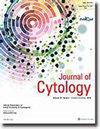Determination of autophagy in human cervicovaginal smears by cytological and İmmunocytochemical methods
IF 1
4区 医学
Q4 MEDICAL LABORATORY TECHNOLOGY
引用次数: 0
Abstract
Background: Autophagy is a catabolic process whereby organelles and long-lived proteins are recycled through lysosomes to maintain cellular homeostasis. This process is being widely studied using culture techniques and animal models; however, cervicovaginal smears have not been used to detect autophagy. Aims: Our study aims to detect and evaluate autophagy in normal, malignant, infectious, and atypical cells in cervicovaginal smears by using cytological and immunocytochemical methods. Materials and Methods: Papanicolaou-stained 200 cervicovaginal smears were examined and 55 of 200 (27.5%) smears containing negative for intraepithelial lesion or malignancy (NILM) with identifiable infections and/or reactive/reparative changes (INF); briefly, NILM-INF (n = 31, 56.4%), atypical (n = 4, 7.3%), and malignant cells (n = 20, 36.3%) were evaluated as a study group. One hundred forty-five of 200 (72.5%) normal smears were accepted as the NILM without any identifiable infections (control group). The autophagy marker protein Microtubule-associated protein 1 light chain 3 A (MAP1LC3A) was used for immunocytochemical examination. Results: The staining intensity of the MAP1LC3A protein and autophagy positivity were lower in the malignant cells; however, they were higher in the NILM-INF and atypical cells. A statistically significant correlation between the malignant and normal cells was obtained for the autophagy positivity (P = 0.012). In view of the staining intensity of MAP1LC3A protein by the H-score method, a significant correlation was found between the NILM-INF and the normal cells (P = 0.015). Conclusions: Autophagy was detected in various cervicovaginal smears for the first time in this study. Our findings indicate that an autophagy process is essential in infectious cells as well as in the transformation of atypical cells into malignant cells in carcinogenesis.细胞学和İmmunocytochemical方法测定人宫颈阴道涂片自噬
背景:自噬是一种分解代谢过程,通过溶酶体循环利用细胞器和长寿命蛋白质来维持细胞稳态。这一过程正在利用培养技术和动物模型进行广泛研究;然而,宫颈阴道涂片尚未用于检测自噬。目的:应用细胞学和免疫细胞化学方法检测和评价宫颈阴道涂片中正常、恶性、感染性和非典型细胞的自噬情况。材料和方法:对200份宫颈阴道涂片进行巴氏染色检查,其中55份(27.5%)涂片上皮内病变或恶性肿瘤(NILM)阴性,伴有可识别的感染和/或反应性/修复性改变(INF);简而言之,将NILM-INF (n = 31, 56.4%)、非典型(n = 4, 7.3%)和恶性细胞(n = 20, 36.3%)作为研究组进行评估。200份正常涂片中的145份(72.5%)被接受为无任何可识别感染的NILM(对照组)。免疫细胞化学检测自噬标记蛋白微管相关蛋白1轻链3a (MAP1LC3A)。结果:恶性肿瘤细胞中MAP1LC3A蛋白染色强度和自噬阳性较低;而在NILM-INF细胞和非典型细胞中则较高。恶性细胞自噬阳性与正常细胞有统计学意义(P = 0.012)。从H-score法对MAP1LC3A蛋白的染色强度来看,NILM-INF与正常细胞呈显著相关(P = 0.015)。结论:本研究首次在各种宫颈阴道涂片中检测到自噬。我们的研究结果表明,在癌变过程中,自噬过程在感染性细胞以及非典型细胞向恶性细胞的转化中是必不可少的。
本文章由计算机程序翻译,如有差异,请以英文原文为准。
求助全文
约1分钟内获得全文
求助全文
来源期刊

Journal of Cytology
MEDICAL LABORATORY TECHNOLOGY-
CiteScore
1.80
自引率
7.70%
发文量
34
审稿时长
46 weeks
期刊介绍:
The Journal of Cytology is the official Quarterly publication of the Indian Academy of Cytologists. It is in the 25th year of publication in the year 2008. The journal covers all aspects of diagnostic cytology, including fine needle aspiration cytology, gynecological and non-gynecological cytology. Articles on ancillary techniques, like cytochemistry, immunocytochemistry, electron microscopy, molecular cytopathology, as applied to cytological material are also welcome. The journal gives preference to clinically oriented studies over experimental and animal studies. The Journal would publish peer-reviewed original research papers, case reports, systematic reviews, meta-analysis, and debates.
 求助内容:
求助内容: 应助结果提醒方式:
应助结果提醒方式:


